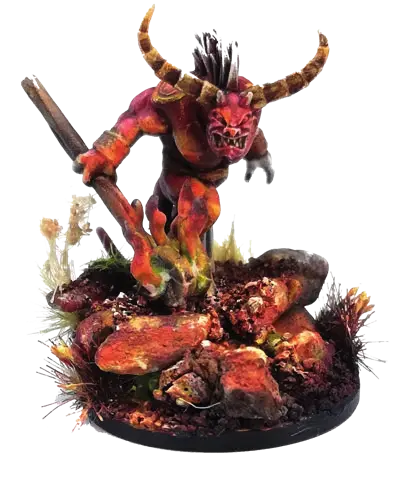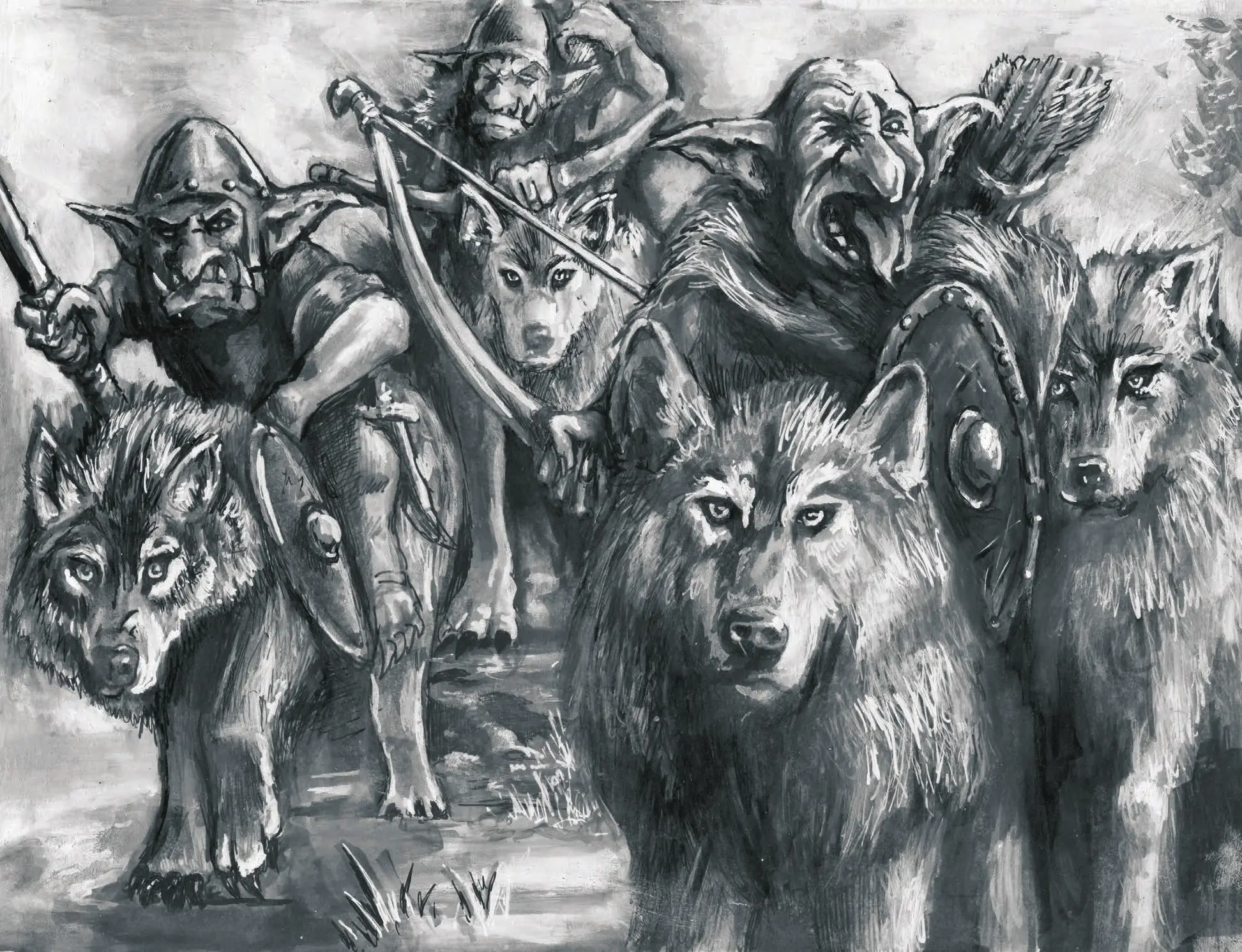Introducing Warmaster
Warmaster is a game of conflict on a grand scale, fought over an area of ground that we might imagine to be many miles square. Although our models are approximately 10mm high this should not be taken as a literal representation of scale when it comes to the size of the battlefield.
The area occupied by a regiment of models is assumed to encompass hundreds of warriors including all of their supporting elements such as mules laden with spare ammunition, surgeons’ wagons, preachers, servants, messengers, scouts and all the paraphernalia of warfare. Never mind that the actual number of warriors depicted is typically about 30–40 in the case of an infantry regiment – we must imagine the formation whole and glorious as it marches to battle! This abstraction, by which a few models are taken to represent many more actual warriors, shouldn’t concern us too much during play, although it has a direct bearing on the way the rules have been formulated.
Similarly, when considering the distances moved by our troops it is wise to think of a standard move of 20cm or 30cm as representing a unit redeploying into a new position from which it is able to launch attacks or push groups of warriors forward to shoot, skirmish or scout ahead. Where troops charge their enemies it would be inappropriate to imagine them running hell for leather over this entire distance – rather, they march into position, deploy their ranks appropriately and cover only the very final part of their manoeuvre at anything like a hurried pace. Hence, movement distances in Warmaster are dependent upon a unit’s deployment and command structure rather than on the notional speed of an individual warrior.
Because Warmaster units represent such large bodies of troops, the rules for combat emphasise the position of units rather than the weapons with which individual warriors are armed. Troops that are in advantageous terrain or supported by friends obviously fight more effectively. Even poor quality troops will fight relatively well in these circumstances. On the other hand, casualties suffered have a direct bearing on a unit’s effectiveness, not only making it weaker in combat but also eroding its logistical support, making it harder for the general to direct as he wishes.
A comparable approach has been taken to missile ranges. In the game, a bow can shoot as far as 30cm but this represents a longer distance than a bow could really shoot. This distance is not based on the range of a bow but the tactical area that a missile armed regiment is able to cover. We might imagine the regimental commander sending individual detachments forward or edging the line to and fro to entice the enemy to their doom! For this reason missile ranges are not based entirely on theoretical weapon ranges – we are interested in the much broader ability of a missile-armed regiment to dominate the ground in front of it.
The most important aspect of the game is the role allotted to the armies’ commanders. Warmaster is based around the ability of generals and their subordinate commanders to control the action around them. In the game this is accomplished by dice rolls but in reality we might picture the general and his staff bent over maps, eagerly awaiting word from their subordinates, reading reports of distant fighting and dispatching messengers with fresh orders. Generals influence the action around them by directing troops – their role as combatants is not especially significant – although a commander’s immediate presence can inspire troops to that extra bit of effort at critical moments!

The game rules
The following pages contain all the rules for the Warmaster game. We suggest that you read through them before attempting to play but don’t worry about trying to learn the game by heart. It’s far better to get stuck in! You can always check out the rules as you go along. After a few games you’ll find the basic routines are easily remembered whilst more unusual rules can be looked up as required. The rules are presented with summaries at the beginning of each section.
Dice
The Warmaster game uses dice to represent the chance element of shooting and close combat. To save space we refer to an individual six-sided dice as a ‘D6’. So when we instruct you to roll a D6 we are simply asking you to roll a dice.
Sometimes you’ll be required to roll two dice and add the scores together, in which case we will ask you to roll ‘2D6’. Occasionally, you will need to roll one dice and multiply the score by another number, in which case we write this as D6 × 10, or D6 × 5 and so on.
In a few instances the rules will also ask you to roll a ‘D3’. This is simply a convenient way of referring to a random roll of between 1 and 3 achieved by rolling a normal D6 and halving the score rounding up. So, a D3 roll of 1–2 = 1, 3–4 = 2, and 5–6 = 3.

Rulers & tape measures
In the Warmaster game, units move across the battlefield by a measured distance. When troops shoot it will be necessary to measure to ensure that they are in range. All distances are given in centimetres. We recommend that players purchase one or more retractable tape measures for measuring distances.
During the game, players are permitted to measure as and when they wish. In many cases, this will be necessary in order to determine which target to shoot or charge.
Players who prefer to play using inches can do so by halving the value of all the distances given. This gives slightly longer moves and ranges but makes no practical difference so long as both sides use inches.
Players will find it useful to have a few coloured dice to use as ‘Hit’ markers. Any spare dice can be used in this way but visually distinct dice are better as they reduce the change of the players picking the up and rolling them during the heat of battle. Alternatively, some players like to devise suitable ‘Hit’ markers such as card chits.
You may also find it handy to have a few small tokens to temporarily mark a spot or remind yourself of a unit’s status – card chits, small coins or tiddly-winks will do just fine.
Zone indicator
A card zone indicator is a useful mechanical guide that enables you to easily work out front, side and rear zones for individual stands as described in the rules for the charge move.
A plea
When playing a tabletop wargame, it is impossible to be absolutely precise when it comes to measurements. Stands can get knocked out of position, terrain can fall over, and what happens when the cat decides to help doesn’t bear thinking about! No matter how careful the players are, it can often prove practically impossible to tell if a unit is in range or out of range, in sight or out of sight, and so on. In marginal cases, where a judgement is difficult, it is fairest and most convenient to let a random dice roll decide – 1, 2, 3 one way, 4, 5, 6 the other. This will resolve the situation and allow the game to continue in good humour.
Many players find the same kind of random roll a perfectly good way of solving niggling rules disputes during play. If you’re not exactly sure of how to interpret a rule and can’t find the answer easily in the manual, then rather than bogging down the game, just roll a dice to decide and get on with the battle. You can always check afterwards or come up with a more considered interpretation ready for the next game.
Get stuck in
Although the scope and pageant of the game can only be realised by playing with miniature armies, for the purpose of learning the rules you might want to improvise by making your own troop stands from card. This will enable you to get a feel of how the game works right from the start.
Similarly, you may want to field unpainted models that you buy. You can paint your army later but this will take time so it’s best to learn the game and fight a few battles first.
Nothing else is needed, though a pen and paper are useful for making notes and a nice hot cup of tea is always a good idea!
